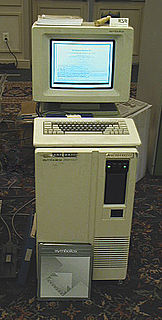Related Research Articles
APL is a programming language developed in the 1960s by Kenneth E. Iverson. Its central datatype is the multidimensional array. It uses a large range of special graphic symbols to represent most functions and operators, leading to very concise code. It has been an important influence on the development of concept modeling, spreadsheets, functional programming, and computer math packages. It has also inspired several other programming languages.

Computer science is the study of computation and information. Computer science deals with theory of computation, algorithms, computational problems and the design of computer systems hardware, software and applications. Computer science addresses both human-made and natural information processes, such as communication, control, perception, learning and intelligence especially in human-made computing systems and machines.

In artificial intelligence, an expert system is a computer system that emulates the decision-making ability of a human expert. Expert systems are designed to solve complex problems by reasoning through bodies of knowledge, represented mainly as if–then rules rather than through conventional procedural code. The first expert systems were created in the 1970s and then proliferated in the 1980s. Expert systems were among the first truly successful forms of artificial intelligence (AI) software. An expert system is divided into two subsystems: the inference engine and the knowledge base. The knowledge base represents facts and rules. The inference engine applies the rules to the known facts to deduce new facts. Inference engines can also include explanation and debugging abilities.

The USC Information Sciences Institute (ISI) is a component of the University of Southern California (USC) Viterbi School of Engineering, and specializes in research and development in information processing, computing, and communications technologies. It is located in Marina del Rey, California.
IBM PC compatible computers are similar to the original IBM PC, XT, and AT that are able to use the same software and expansion cards. It was developed by Business Machine and PC corporation IBM. Such computers were referred to as PC clones, or IBM clones. The term "IBM PC compatible" is now a historical description only, since IBM no longer sells personal computers. The industry jargon "PC" sometimes doesn't mean "personal computer" generally, but rather a computer running Microsoft's Windows operating system, in contrast to Apple's macOS, which usually gives the computer the designation of "Mac".

Db2 is a family of data management products, including database servers, developed by IBM. They initially supported the relational model, but were extended to support object-relational features and non-relational structures like JSON and XML. The brand name was originally styled as DB/2, then DB2 until 2017 and finally changed to its present form.
A management information system (MIS) is an information system used for decision-making, and for the coordination, control, analysis, and visualization of information in an organization.

IBM Research is the research and development division for IBM, an American multinational information technology company headquartered in Armonk, New York, with operations in over 170 countries. IBM Research is the largest industrial research organization in the world and has twelve labs on six continents.
OfficeVision was an IBM proprietary office support application that primarily ran on IBM's VM operating system and its user interface CMS.
In artificial intelligence, model-based reasoning refers to an inference method used in expert systems based on a model of the physical world. With this approach, the main focus of application development is developing the model. Then at run time, an "engine" combines this model knowledge with observed data to derive conclusions such as a diagnosis or a prediction.
International Business Machines (IBM), nicknamed "Big Blue", is a multinational computer technology and IT consulting corporation headquartered in Armonk, New York, United States. IBM originated from the bringing together of several companies that worked to automate routine business transactions, including the first companies to build punched card based data tabulating machines and to build time clocks. In 1911, these companies were amalgamated into the Computing-Tabulating-Recording Company (CTR).

Computer-aided detection (CADe), also called computer-aided diagnosis (CADx), are systems that assist doctors in the interpretation of medical images. Imaging techniques in X-ray, MRI, and ultrasound diagnostics yield a great deal of information that the radiologist or other medical professional has to analyze and evaluate comprehensively in a short time. CAD systems process digital images for typical appearances and to highlight conspicuous sections, such as possible diseases, in order to offer input to support a decision taken by the professional.
Artificial intelligence, defined as intelligence exhibited by machines, has many applications in today's society. More specifically, it is Weak AI, the form of AI where programs are developed to perform specific tasks, that is being utilized for a wide range of activities including medical diagnosis, electronic trading platforms, robot control, and remote sensing. AI has been used to develop and advance numerous fields and industries, including finance, healthcare, education, transportation, and more.

Medical diagnosis is the process of determining which disease or condition explains a person's symptoms and signs. It is most often referred to as diagnosis with the medical context being implicit. The information required for diagnosis is typically collected from a history and physical examination of the person seeking medical care. Often, one or more diagnostic procedures, such as medical tests, are also done during the process. Sometimes posthumous diagnosis is considered a kind of medical diagnosis.

Watson is a question-answering computer system capable of answering questions posed in natural language, developed in IBM's DeepQA project by a research team led by principal investigator David Ferrucci. Watson was named after IBM's founder and first CEO, industrialist Thomas J. Watson.
ENB is a medical procedure utilizing electromagnetic technology designed to localize and guide endoscopic tools or catheters through the bronchial pathways of the lung. Using a virtual, three-dimensional (3D) bronchial map from a recently computed tomography (CT) chest scan and disposable catheter set, physicians are able to navigate to a desired location within the lung to biopsy lesions, stage lymph nodes, insert markers to guide radiotherapy or guide brachytherapy catheters.

International Business Machines Corporation (IBM) is an American multinational technology company headquartered in Armonk, New York. It was founded in 1911 in Endicott, New York, as the Computing-Tabulating-Recording Company (CTR) and was renamed "International Business Machines" in 1924. IBM is incorporated in New York and has operations in over 170 countries.
Software diagnosis refers to concepts, techniques, and tools that allow for obtaining findings, conclusions, and evaluations about software systems and their implementation, composition, behavior, and evolution. It serves as means to monitor, steer, observe and optimize software development, software maintenance, and software re-engineering in the sense of a business intelligence approach specific to software systems. It is generally based on the automatic extraction, analysis, and visualization of corresponding information sources of the software system. It can also be manually done and not automatic.

Artificial intelligence in healthcare is the use of complex algorithms and software in other words artificial intelligence (AI) to emulate human cognition in the analysis, interpretation, and comprehension of complicated medical and healthcare data. Specifically, AI is the ability of computer algorithms to approximate conclusions without direct human input.

IBM Watson Health is a division of the International Business Machines Corporation, (IBM), an American multinational information technology company headquartered in Armonk, New York. It helps clients facilitate medical research, clinical research, and healthcare solutions, through the use of artificial intelligence, data, analytics, cloud computing, and other advanced information technology.
References
- ↑ Salcudean, S. E.; Bell, G.; Bachmann, S.; Zhu, W. H.; Abolmaesumi, P.; Lawrence, P. D. (1999), "Robot-Assisted Diagnostic Ultrasound - Design and Feasibility Experiments", Miccai99, Lecture Notes in Computer Science, Springer, 1679: 1062–1071, doi: 10.1007/10704282_115 , ISBN 978-3-540-66503-8
- ↑ Dario, P.; Bergamasco, M. (1988), "An advanced robot system for automated diagnostic tasks through palpation", IEEE Transactions on Biomedical Engineering, 35 (2): 118–126, doi:10.1109/10.1349, PMID 3350538, S2CID 24390579
- ↑ Upbin, Bruce (2013-02-08). "IBM's Watson Gets Its First Piece Of Business In Healthcare". Forbes. Retrieved March 10, 2013.
- ↑ Cohn, Jonathan (March 2013). "The Robot Will See You Now". The Atlantic.